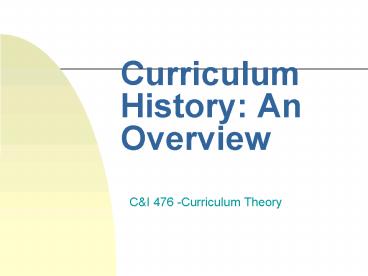Curriculum History: An Overview - PowerPoint PPT Presentation
1 / 20
Title:
Curriculum History: An Overview
Description:
Franklin found the traditional curriculum too narrow ... science and religion in his curriculum. ... Curriculum became more practical and of social utility. ... – PowerPoint PPT presentation
Number of Views:49
Avg rating:3.0/5.0
Title: Curriculum History: An Overview
1
Curriculum History An Overview
- CI 476 -Curriculum Theory
2
Three focal points for curricular decisions
- The nature of subject matter - Are some kinds of
subject matter more intrinsically worthwhile then
others? - The nature of society - What knowledge is useful
to apply in the world? - The nature of the individual - Can the same
curriculum be equally appropriate for all
individuals?
3
The Colonial Era and the Early United States
- Two assumptions were shared about education
- 1) Only a few people needed much formal
education. - Most needed learning occurred in the home, in
apprenticeships, and through actions of daily
living.
4
Exception Massachusetts in
1647 passed a law for the establishment of Latin
grammer schools to teach rudimentary reading and
writing skills.
5
2) Formal education should be
directed at bringing people into conformity with
the prevailing idea of what an educated person
should be, i.e., Christian religious training.
6
Again, the Latin grammar school became
the model. The Latin grammar school was also a
medium to educate future clergy (teaching Greek,
Latin, and occasionally Hebrew).
7
Both assumptions led to a
subject matter curriculum that provided access to
central and eternal truths of the Holy
Scriptures. Such focus on truths rather than life
in the world led to a development in America that
the activities of schooling, directed at
cultivating the mind and the soul, were separated
from the practical activities outside of schools
8
A Failed Exception Franklins Academy
- Created by Benjamin Franklin in 1749
9
A Failed Exception Franklins Academy
- Created by Benjamin Franklin in 1749
- Emphasized training in practical subjects.
Franklin found the traditional curriculum too
narrow
10
A Failed Exception Franklins Academy
- Created by Benjamin Franklin in 1749
- Emphasized training in practical subjects.
Franklin found the traditional curriculum too
narrow - Franklin included physical education, drawing,
mechanical arts, mathematics, history, geography,
civics, horticulture, science and religion in his
curriculum.
11
Though Franklins academy was
not successful, it introduced Americans to the
idea that the nature of society could also serve
as a focal point for making decisions about the
curriculum. His ideas also foreshadowed
developments in the 19th Century.
12
The Nineteenth Century
- At the beginning of the century a few people were
taught a few , well-ordered subjects. However,
many Americans began to accept the notion that
the masses could become educated.
13
Perhaps the biggest influence of these ideas were
Americas experience with political
democracyDemocracy required broad political
participation and thus everyone needed some
formal education
14
- Society also became more urbanized and
industrialized.
15
- Society also became more urbanized and
industrialized. - Curriculum became more practical and of social
utility.
16
- Society also became more urbanized and
industrialized. - Curriculum became more practical and of social
utility. - Compulsory school attendance laws were passed.
17
By the beginning of the 19th Century Franklins
ideas of an academy was realized
18
By the beginning of the 19th Century Franklins
ideas of an academy was realized
- to meet the needs of a growing middle class
19
By the beginning of the 19th Century Franklins
ideas of an academy was realized
- to meet the needs of a growing middle class
- supported the idea that a natural aristocracy
of virtue and talent should replace a ruling
aristocracy based on wealth and birth
20
Common School Movement
- Summarize any actions required of your audience
- Summarize any follow up action items required of
you































